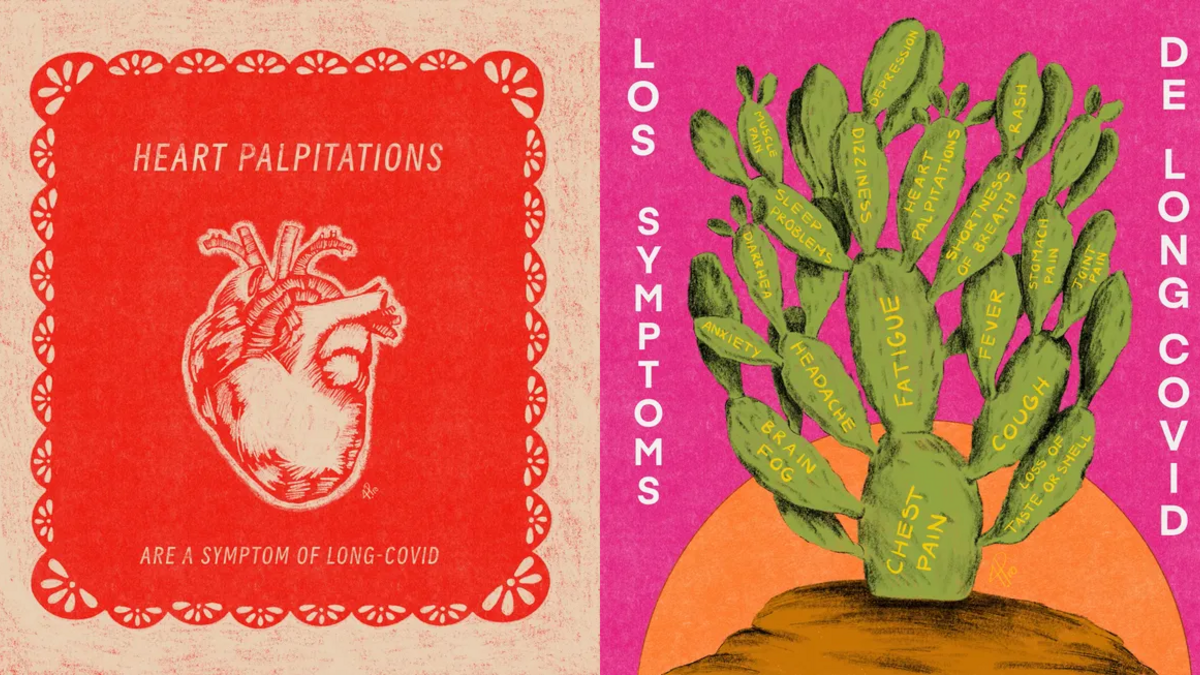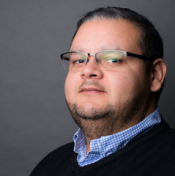Health communication program brings long COVID awareness to Latinos

COVIDLatino's latest campaign aims to bring awareness about long COVID to Latino communities by combining art and science. Andrea Pro, a Chicana painter, illustrator and designer who earned her BFA in painting from ASU in 2021, collaborated with the health communication program to create several infographics like the ones seen above. Courtesy images
After COVID-19 hit the Latino community especially hard, Gilberto Lopez created COVIDLatino, a health communication program designed to share accurate, timely, evidence-based and culturally tailored messaging about COVID with Latino communities.
Now, the program has begun a new campaign to bring awareness about long COVID — including symptoms of the disease, like fatigue, shortness of breath, brain fog and trouble sleeping, that can linger for weeks or months after infection — to Latinos.
"We did focus-groups and interviews and found that, in the Latino community, people don’t have a sense that these different symptoms are somehow connected to COVID," said Lopez, a Charter Professor at Arizona State University's School of Transborder Studies. "Most of them have not heard of long COVID, so we want to bring awareness to it."
Through artist collaborations, COVIDLatino has created effective health messaging with comics, animations, infographics and other artworks that resonate with and impact Latino communities in clear, measurable and meaningful ways.
ASU News spoke with Lopez to learn more about COVIDLatino and its newest campaign about long COVID.
Editor's note: Answers have been edited for length and clarity.
Question: Can you tell us what exactly COVIDLatino is?
Answer: COVIDLatino is a health communication and education campaign for Latinos across Arizona, but also across the Southwest and nationally. The goal is to get accurate, timely, evidence-based COVID information to the Latino community in culturally tailored ways that are super easy to understand. We do that by combining the arts and science to create infographics, cartoons and animations.
Q: Why is it important that this information is culturally tailored to this community?
A: When the pandemic hit, information was not coming through to our communities equally in the same quality and quantity. But if we’re trying to push equity, we need to make information more accessible and we need to make sure that the community gets information in ways they understand. Agencies were putting out information in Spanish, but it was just translated. When you culturally tailor something, it sticks and resonates with the community.
Q: How were you able to measure the impact of this culturally tailored information?
A: We measured it in many different ways. We did a few clinical trials to assess if people learn from these animations. And yes, we saw that there was a significant increase in their knowledge about COVID information after they saw an animation compared to before. We also did a qualitative assessment by asking people what they thought of the animations, if they resonated, and for overall feedback.
We found that it resonated with people because they liked the voices that sounded familiar to them, especially the Mexican American community.
Q: Could you tell us about the previous and current COVIDLatino campaigns?
A: We started with information about masking, social distancing and basic information about testing. Then the campaign shifted to vaccines when those came out. We were bringing awareness about vaccinations and what’s in them and what’s not. Now we’re focusing on long COVID.
We did focus groups and interviews and found that, in the Latino community, people don’t have a sense that these different symptoms are somehow connected to COVID. Most of them have not heard of long COVID, so we want to bring awareness to it.
On March 15, which was International Long COVID Awareness Day, we launched our newest campaign in collaboration with two artists. ASU alumna Andrea Pro is doing a couple of pieces for us using cultural iconography, desert themes and Latino themes to bring awareness about long COVID symptoms.
We also collaborated with Lalo Alcaraz, who’s an artist-in-residence here at the School of Transborder Studies. With him, we’re doing animations. He’s helping us with the artwork and the writing of the animations, and we’re putting that into production.
Q: Is there anything else you’d like us to know about COVIDLatino?
A: For the project itself, I think it’s important that we give accurate health and scientific information to the community because health science, and science in general, is going through a crisis. People don’t believe in researchers and scientists, so it’s important that we try not to be patronizing and really make it accessible to the community.
More Health and medicine

ASU, University of Wisconsin partner to empower Black people to quit smoking
Arizona State University faculty at the College of Health Solutions are teaming up with the University of Wisconsin to determine which treatments work best to empower Black people to quit…

New book highlights physician wellness, burnout solutions
Health care professionals dedicate their lives to helping others, but the personal toll of their work often remains hidden.A new book, "Physician Wellness and Resilience: Narrative Prompts to Address…

80 years of pioneering speech and hearing services for the community
Over 80 years ago, in 1937, the first course in communication disorders, Speech Correction, was offered at Arizona State University. As additional courses were added and programs in speech…
